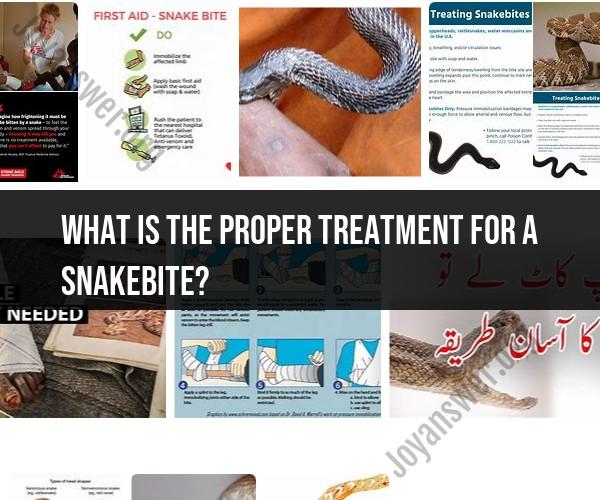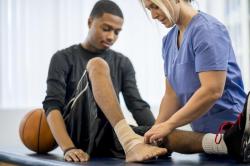What is the proper treatment for a snakebite?
The proper treatment for a snakebite involves a combination of first aid measures and medical interventions. It's essential to seek immediate medical attention in the event of a snakebite, as the specific treatment can vary depending on factors such as the type of snake, the amount of venom injected, and the individual's reaction to the bite. Here are the steps to follow:
Call for Help: Dial emergency services (911 or the local emergency number) immediately. Professional medical assistance is critical for snakebite treatment.
Stay Calm: Try to keep the victim calm and still. Panicking can increase heart rate and the spread of venom through the bloodstream.
Keep the Bitten Limb Immobilized: Encourage the victim to keep the bitten limb as still as possible. Immobilization can help slow the spread of venom. Avoid using a tourniquet, as it can be harmful.
Position the Limb: Keep the bitten limb at or slightly below heart level. This can also help reduce the spread of venom.
Remove Tight Clothing and Jewelry: Snakebite swelling can occur rapidly, so remove any tight clothing, jewelry, or accessories near the bite site to allow for swelling.
Clean the Wound: Gently clean the wound with mild soap and water to reduce the risk of infection. Do not scrub the area.
Apply a Clean Bandage: Cover the bite with a clean, sterile dressing to keep it clean and protect it from further injury.
Do Not Cut or Suck the Wound: Contrary to popular myths, cutting the wound or attempting to suck out venom is not effective and can be harmful.
Do Not Apply Ice or Heat: Avoid using ice packs or heat pads on the bite site, as they can worsen tissue damage.
Do Not Use a Venom Extraction Kit: These kits are not recommended for snakebite treatment and can be ineffective or harmful.
Keep the Victim Calm: Stress and anxiety can worsen the effects of venom, so try to keep the victim as calm as possible.
Monitor Vital Signs: Keep an eye on the victim's vital signs, including breathing, pulse, and level of consciousness. Be prepared to perform CPR if necessary.
Identify the Snake: If it can be done safely and without further endangering anyone, try to identify the snake's characteristics, such as color, size, and markings. This information can be helpful for medical professionals in determining the appropriate antivenom.
Do Not Try to Capture or Kill the Snake: Attempting to capture or kill the snake is not recommended, as it can be dangerous and may lead to further bites.
Seek Medical Treatment: Even if the bite appears to be minor, seek medical attention promptly. The definitive treatment for snakebites is antivenom, which can only be administered in a healthcare facility.
Treatment for a snakebite can be complex, and the appropriate antivenom and medical care depend on the type of snake involved. Therefore, always err on the side of caution and seek professional medical help immediately. Time is critical in snakebite cases, and early intervention can greatly improve the outcome.
Snakebite First Aid: Proper and Timely Treatment
Snakebite first aid is essential for improving the chances of survival and recovery. The following steps should be taken immediately after a snakebite:
- Stay calm and move away from the snake. Avoid panicking or moving around too much, as this can cause the venom to spread more quickly through your body.
- Identify the snake, if possible. This will help medical personnel to determine the type of venom you have been exposed to and to provide the correct treatment.
- Remove any jewelry or clothing that is constricting the bite area.
- Wash the bite site with soap and water.
- Elevate the bitten limb above heart level.
- Apply a loose, pressure bandage to the bite site. Do not use a tourniquet, as this can restrict blood flow and cause further damage.
- Seek medical attention immediately.
Ensuring the Best Outcome: Treating Snakebites the Right Way
The best outcome for a snakebite victim is achieved through timely and appropriate treatment. This includes administering antivenom as soon as possible. Antivenom is a medication that neutralizes the effects of snake venom and is the most effective treatment for snakebites.
In addition to antivenom, snakebite victims may also need supportive care, such as pain medication, antibiotics, and wound care. The severity of the envenomation will determine the length of time that a snakebite victim needs to stay in the hospital.
The Importance of Swift and Appropriate Snakebite Care
Snakebite is a medical emergency that requires swift and appropriate care. The sooner a snakebite victim receives medical attention, the better their chances of survival and recovery.
If you or someone you know is bitten by a snake, it is important to seek medical attention immediately. Call 911 or your local emergency number.













